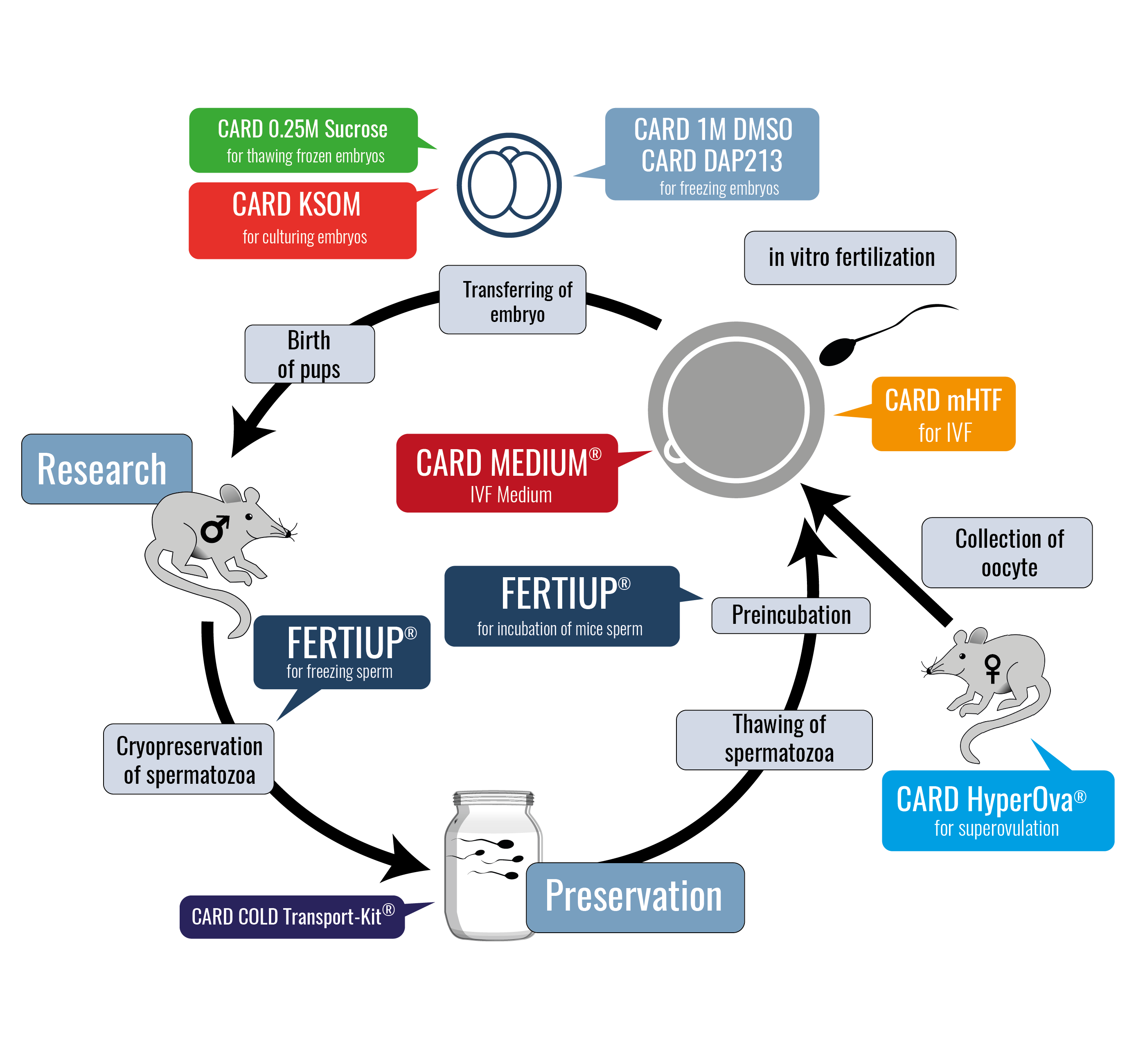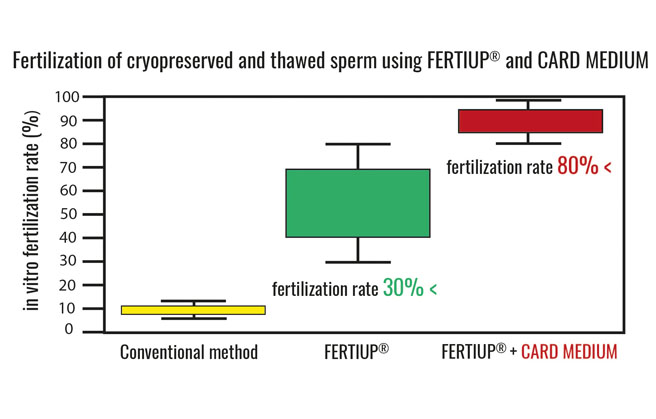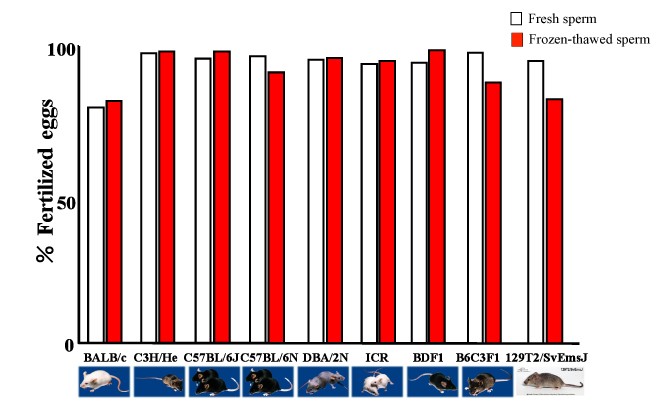Assisted reproductive technologies
Introduction
In recent years, the number of genetically engineered mice being produced has increased dramatically. Moreover, the rapid progress in the development of genome-editing (TALEN and CRISPR/Cas9) techniques for molecular biology reserach has been remarkable, so much so that a genetically engineered mouse strain can be produced easily in a few months. Production has been supported by reproductive engineering techniques such as In vitro fertilisation, embryo and sperm cryopreservation and embryo transfer techniques. Such techniques have become invaluable peripheral technologies and their use is expanding rapidly.

Overview
To support your research we offer several reagents and disposable items (general labware) for In vitro fertilisation, In vitro culture, cryopreservation and In vitro manipulation.
CARD MEDIUM® and FERTIUP®
Sperm cryopreservation is a practical and cost-effective method of archiving mouse strains in the laboratory. FERTIUP® and CARD MEDIUM® are high-performance media for mouse sperm cryopreservation, sperm preincubation and In vitro fertilization (IVF).
When used in combination, FERTIUP® and CARD MEDIUM® provide a high and stable fertilization rate using frozen-thawed mouse sperm. This will allow you to reproduce mice whenever you need them.
The FERTIUP® sperm cryoprotectant and sperm preincubation medium greatly improve fertilization rates of frozen-thawed sperm in C57BL/6 and 129 Mice strains, from less than 10% (using conventional methods) to more than 30%.
In addition, CARD MEDIUM® enhances the fertility rate to over 80%. FERTIUP® and CARD MEDIUM® have no reproduction toxicity of any kind.
The newly developed system for sperm cryopreservation and IVF using FERTIUP® and CARD MEDIUM® provides superior support for the safe and reliable preservation of your valuable mouse strains.
| No. | Strains | Method | Number of oocytet donors | Number of inseminated oocytes | Average number of ovulated oocytes/female | No. of fertilized eggs | Fertilization rate (%) |
|---|---|---|---|---|---|---|---|
| 1 | C57BL/6J | eCG Product |
10 10 |
270 1072 |
27.7±5.4 107.2±22.7 |
267 963 |
96.4±3.2 89.8±3.7 |
| 2 | BALB/c ByJ | eCG Product |
10 10 |
293 903 |
29.3±8.9 90.3±14.5 |
213 680 |
73.4±11.3 76.4±9.0 |
| 3 | C3H/HeJ | eCG Product |
10 10 |
286 520 |
28.6±8.4 52.0±18.1 |
251 446 |
87.8±22.6 85.8±15.5 |
| 4 | DBA/2J | eCG Product |
10 10 |
225 688 |
22.5±7.8 68.8±13.6 |
194 592 |
86.2±11.0 86.0±4.5 |
| 5 | FVB/NJ | eCG Product |
10 10 |
168 256 |
16.8±3.3 25.6±5.9 |
159 239 |
94.6±6.7 93.3±6.6 |
| 6 | CD1 | eCG Product |
10 10 |
202 337 |
20.2±8.0 33.7±9.9 |
146 269 |
72.3±16.0 79.8±19.6 |
Fig. 2:
- 7.5 IU of CARD HyperOva® or PMSG was injected to four weeks old female mice, then 7.5 IU of hCG was administered 48 hours later.
Thereafter all ova obtained 17 hours after the hCG injection were collected. - The In vitro fertilization rate is defined as the number of 2-cell embryos divided by the total number of ova (mean±SD).
- Data cited from a paper published by Prof. Naomi Nakagata and Toru Takeo (Center for Animal Resources and development, Kumamoto University)
 Fig. 3: Fertilization rates using FERTIUP® Preincubation Medium and CARD MEDIUM® for fresh and frozen sperm in various strains.
Fig. 3: Fertilization rates using FERTIUP® Preincubation Medium and CARD MEDIUM® for fresh and frozen sperm in various strains. Fig. 4: Fertilization rates using frozen-thawed sperm with FERTIUP® and with FERTIUP® and CARD MEDIUM®
Fig. 4: Fertilization rates using frozen-thawed sperm with FERTIUP® and with FERTIUP® and CARD MEDIUM®CARD HyperOva® the superovulation reagent
Reduction in experimental animal use (Contribution to 3Rs):
Using CARD HyperOva® enables us to reduce the number of female mice used for ovum collection by 25 - 30 %.
Optimization of genetically modified mouse creation and preservation:
More ova can be obtained from less female mice using CARD HyperOva® than following the conventional method, which will facilitate In vitro fertilization and embryo transfer.
Application to valuable genetically modified mice:
Using CARD HyperOva® on your valuable genetically modified mice enables you to obtain a lot of ova from small number of females, thus enabling the large-scale preparation of embryos.
Periphere products
Additionally to reagents regarding reproductive engineering techniques we offer several instruments. For example a transportation kit for the cauda epididymides or straws to execute In vitro fertilisation steps.
Simplified overview: Reagents for In vitro Fertilization
Besides the regular labware necessary for the mouse in vitro Fertilization, the following sections should help you determine the necessray volumes for your experiments.
Soperovulation using PMSG
Soperovulation is induced by the intraperitoneal injection of 7.5 IU of pregnant mare's serum gonadotropin (PMSG) into each mature female mouse (8 - 12 weeks old).
PMSG is usually administered during the light cycle between hours of 14:00 and 18:00.
48 - 52 hours later, human chorionic gonadotropin (hCG) is injected intraperitoneal.
Ultra-Soperovulation using CARD HyperOva
Soperovulation is induced by the intraperitoneal injection of 0.1 - 0.2 mL of CARD HyperOva into a 26 - 30 day old female mouse (counting date of birth as day 0).
CARD HyperOva is usually administered during the light cycle between hours of 17:00 and 18:00.
48 hours later, 7.5 IU human chorionic gonadotropin (hCG) is injected intraperitoneal.
Preparation of Dishes
General dish preparation
Put some medium on a dish using a micropippete.
Pour liquid paraffin into the dish.
Cover the medium drop with liquid paraffin.
Sperm dish - FERTIUP Preincubation Medium (PM)
1 drop (100 µl / drop) of FERTIUP (PM) is put into a dish and covered with liquid paraffin 30 minutes before collecting sperm.
Subsequently, the dish is placed in an incubator.
Fertilization dish - CARD MEDIUM
1 drop (200 µl / drop per 2 oviducts) of CARD MEDIUM is put into a dish and covered with liquid paraffin 10 minutes before collecting oocytes.
Subsequently, the dish is placed in an incubator.
Note: There are three different methos of preparing CARD MEDIUM, depending on whether in vitro fertilization will be carried out using fresh, frozen-thawed or cold-temperature transported spermatozoa. Please contact us for the CARD MEDIUM instruction manual.
Washing dish - mHTF
4 individual drops (80 µl / drop) of mHTF are put into a dish and covered with liquid paraffin.
Subsequently, the dish is placed in an incubator for at least 30 min.
Cryopreservation of Mouse Spermatozoa in FERTIUP
Preparation of Sperm Suspension - FERTIUP Cryoprotectant (CPA)
1 drop (60 µl / drop) of FERTIUP CPA is put into a 35 mm dish and covered with liquid paraffin.
Add a 60 µl aliquot of the same solution to the drop (final volume: 120 µL) to make a tall, semispherical drop.
Lateer, 10 µL of the Sperm Suspension will be aspirated into a freezin straw.
Preparation of Freezing Straw Containing Sperm Suspension
Loading 100 µL of HTF into the straw prevents the straw from floating on the surface of liquid nitrogen.
In vitro Fertilization using Spermatozoa Cryopreserved in FERTIUP
1 drop (90 µl / drop) of FERTIUP (PM) is put into a dish and covered with liquid paraffin 30 minutes before thawing a frozen straw.
Subsequently, the dish is placed in an incubator (37°C, 5% CO2 in air).
Preparation of Dishes for Fertilization and Washing
1 drop (90 µl / drop per up to 4-6 cumulus-oocytes-complexes (COCs)) of CARD MEDIUM is put into a dish and covered with liquid paraffin 10 minutes before collecting oocytes.
Subsequently, the dish is placed in an incubator (37°C, 5% CO2 in air) for at least 30 minutes.
4 individual drops (80 µl / drop) of HTF are put into a dish and covered with liquid paraffin.
Subsequently, the dish is placed in an incubator (37°C, 5% CO2 in air) for at least 30 min.
Table 2: Overview of the different set and kit components. Please carefully read the manufacturers instructions for determining the right volumes.
| Set / Component (Necessary per Fertilization) | CARD HyperOva (0.1 - 0.2 mL per mouse) |
FERTIUP CPA (60 µL) |
FERTIUP PM (100 µL) (90 µL for cryopreserved spermatozoa) |
CARD MEDIUM (200 µL per 2 oviducts) (90 µL for 4-6 cumulus-oocytes-complexes) |
mHTF (4 x 80 µL) Not present in any set or kit |
|---|---|---|---|---|---|
| KYD-004-EX | 1 ml | 1 Kit (approx. 1.5 mL) | |||
| KYD-005-EX | 0.5 ml | 1 Kit (approx. 1.5 mL) | |||
| KYD-SET | 0.5 ml | 0.5 ml | 1 Kit (approx. 1.5 mL) | ||
| KYD-SET-01 | 0.5 ml | 0.5 ml | |||
| KYD-SET-02 | 1 ml (+ 2mL distilled water) | 0.5 ml | 0.5 ml | ||
| KYD-SET-03 | 1 ml (+ 2mL distilled water) | 0.5 ml | 0.5 ml | 1 Kit (approx. 1.5 mL) | |
| KYD-SET-04 | 1 ml (+ 2mL distilled water) | 0.5 ml | 1 Kit (approx. 1.5 mL) |



